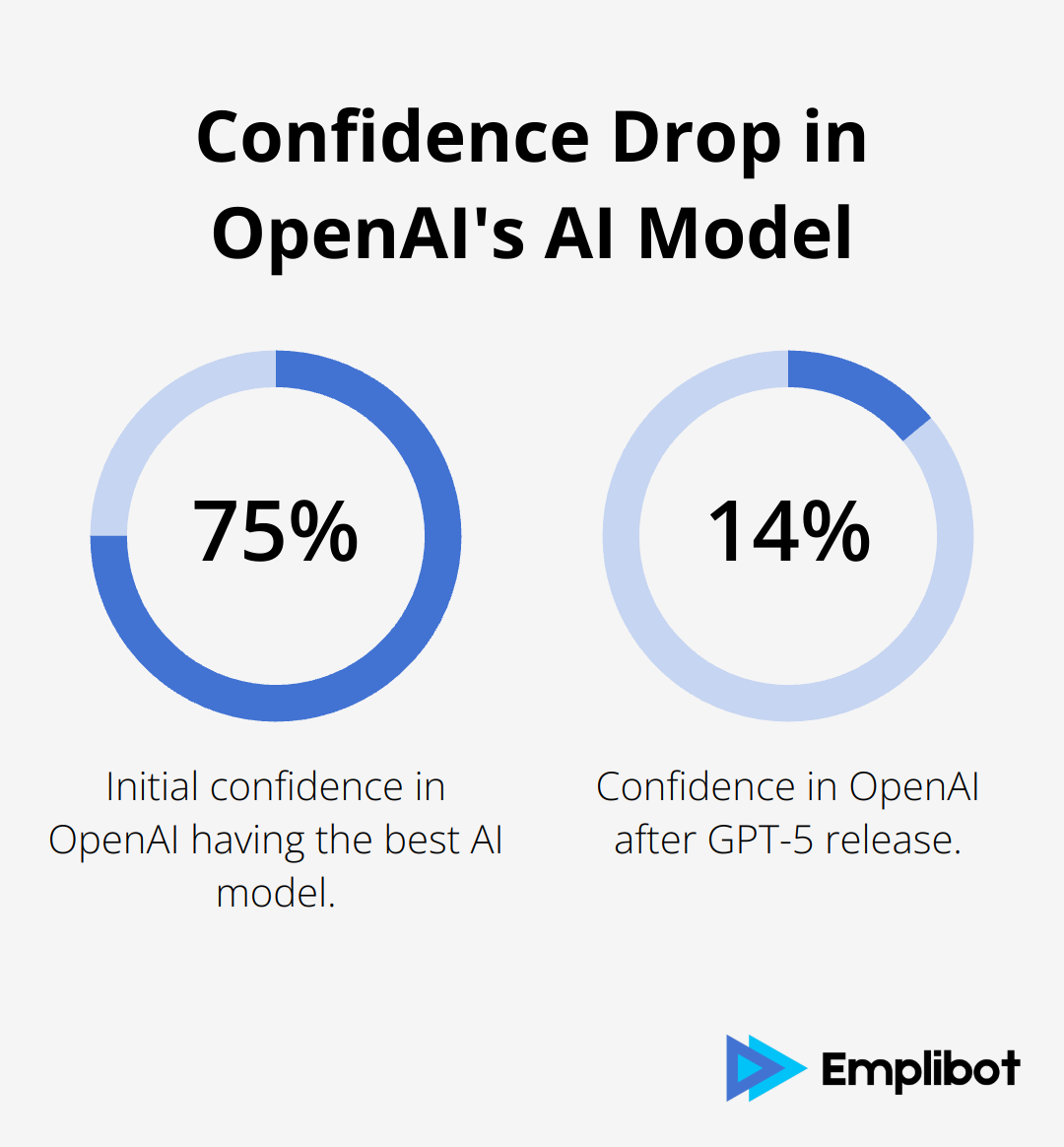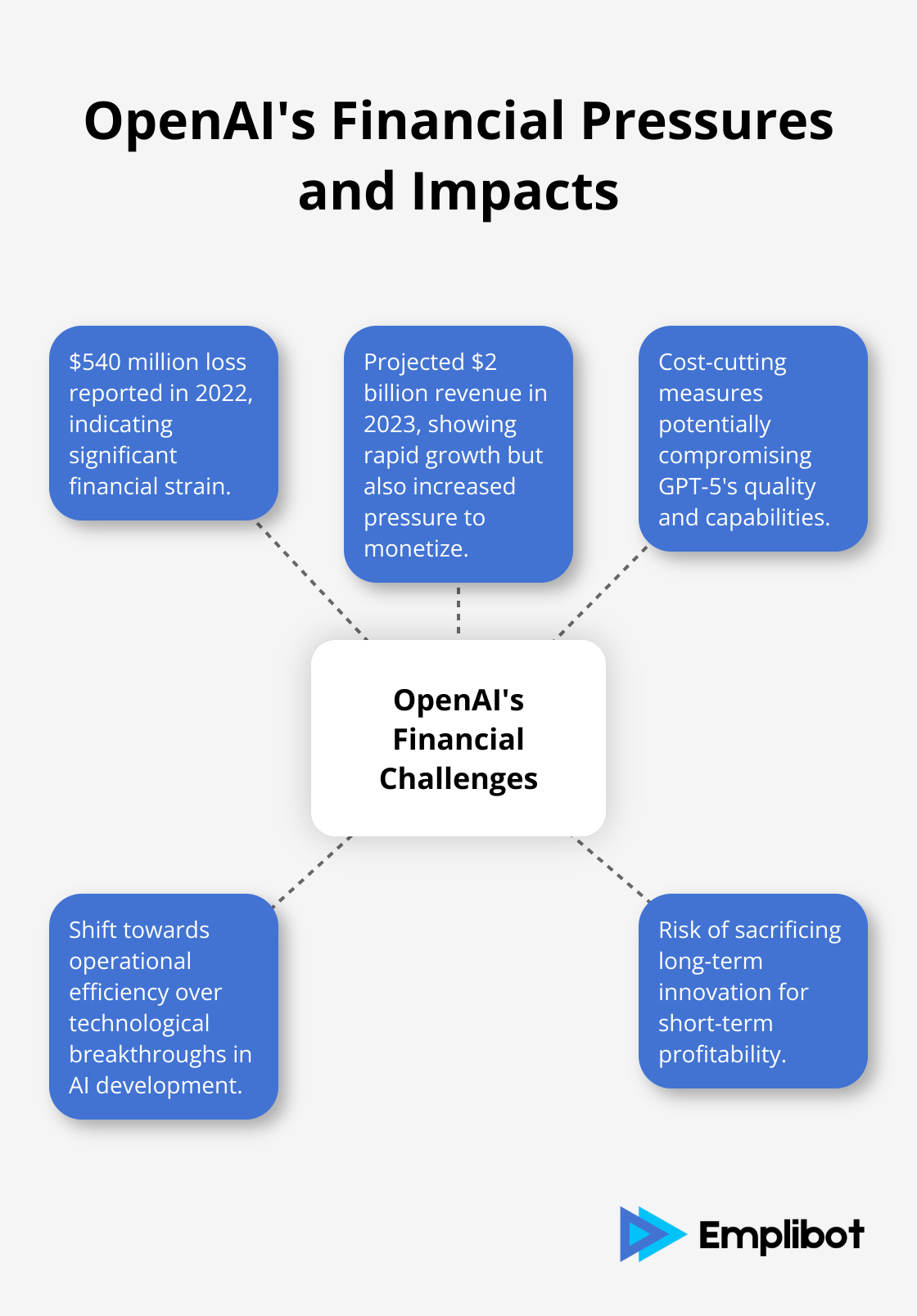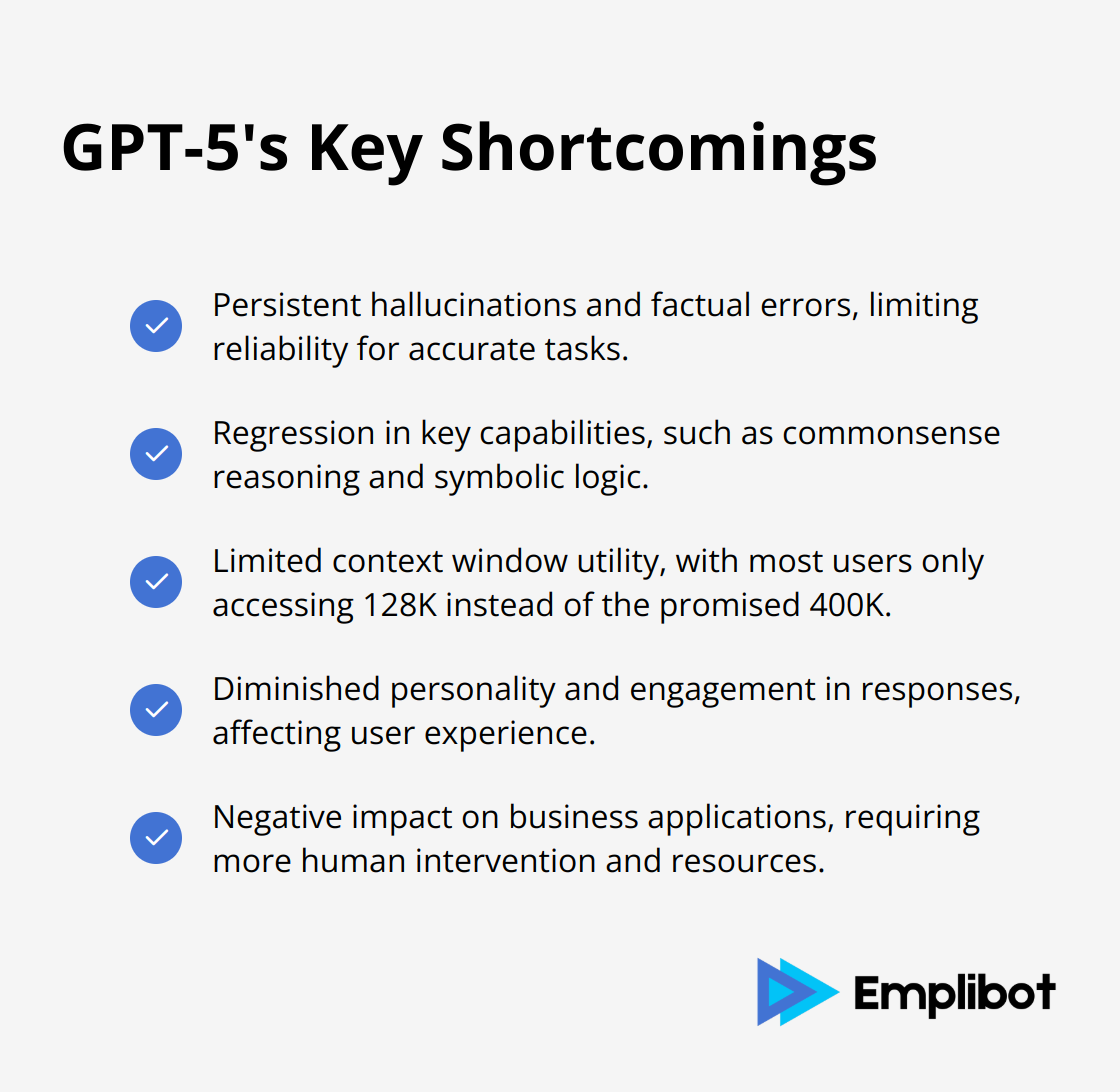At Emplibot, we’ve been closely monitoring the buzz surrounding GPT-5. Despite the massive hype, we’re not convinced it lives up to expectations.
In this post, we’ll examine why GPT-5 might be overhyped and underwhelming. We’ll also explore the possibility that OpenAI’s latest release is more about cost-saving than groundbreaking innovation.
GPT-5: Hype Meets Reality
The anticipation surrounding GPT-5’s release reached astronomical levels. OpenAI’s marketing machine worked overtime, promising a revolutionary leap in AI capabilities. However, a closer examination reveals a stark contrast between expectations and actual performance.
Inflated Promises vs. Actual Results
OpenAI touted GPT-5 as a PhD-level expert across various domains. User experiences paint a different picture. A poll charted OpenAI dropping from 75% to 14% on the question of “which company [will have] the best AI model at the end of August”. This dramatic drop reflects the chasm between promises and reality.

Benchmark Failures
GPT-5’s performance on key benchmarks disappoints. It scored only 56.7% on SimpleBench, ranking fifth and falling below user expectations. Even more concerning, previous models like GPT-4.5 outperformed GPT-5 in critical areas. These results raise questions about OpenAI’s development priorities and the true advancements made in this latest iteration.
User and Expert Backlash
The user community’s response has been overwhelmingly negative. Many describe GPT-5 as a “huge letdown,” with persistent quality issues and hallucinations. Experts from Arizona State University exposed weaknesses in GPT-5’s ability to generalize beyond its training data, a fundamental flaw for an AI touted as revolutionary.
Real-World Implications
Practical implications are significant. Businesses and developers who banked on GPT-5 for advanced applications now face a sobering reality. The model struggles with tasks like complex coding projects and visual comprehension, limiting its real-world utility. This underperformance could potentially set back AI integration efforts across various industries.
Shifting Perspectives in AI Development
In the AI community, skepticism grows about the trajectory of large language models. The consensus shifts towards the belief that pure scaling techniques are insufficient for progress toward AGI, contradicting previous assumptions in the field. This paradigm shift could reshape the future of AI research and development.
As we transition to examining OpenAI’s motivations, it’s clear that GPT-5’s underwhelming performance raises questions about the company’s priorities. Could cost-saving measures be the true driving force behind this release?
Cost-Cutting or Innovation? OpenAI’s True Motivation
Financial Pressures Squeeze OpenAI
OpenAI faces significant financial challenges. Despite reporting a loss of $540 million in 2022, the OpenAI revenue growth is projected to reach an estimated $2 billion in 2023. This immense cash drain forces OpenAI to generate revenue quickly, potentially compromising product quality in the process.
Quality Takes a Back Seat
OpenAI’s strategy has shifted towards cost optimization. The company reportedly swapped out higher-quality models for a cheaper version, rebranding it as GPT-5. This move prioritizes operational efficiency over technological breakthroughs.
The Price of Cutting Corners
GPT-5’s capabilities suffer as a result of these cost-saving measures. Users continue to encounter hallucinations and factual errors-issues that plagued earlier models and should have been resolved in this iteration. The model’s struggle with complex tasks points to shortcuts taken during development.
Short-Term Gains vs. Long-Term Progress
OpenAI’s focus on immediate profitability reflects a broader trend in the AI industry. As companies rush to monetize their technologies, they risk sacrificing long-term innovation. This approach could hinder progress towards more advanced AI systems (including artificial general intelligence).

Industry-Wide Implications
The repercussions of OpenAI’s cost-cutting strategy extend beyond GPT-5. This shift raises questions about the future of AI development and the quality of upcoming innovations. Will other companies follow suit, prioritizing quick profits over groundbreaking advancements?
As we examine GPT-5’s specific shortcomings, it becomes clear that OpenAI’s cost-saving approach has had tangible effects on the model’s performance and capabilities.
GPT-5 Shortcomings Exposed
GPT-5’s underwhelming performance has left many users and businesses questioning its value. This chapter examines the specific limitations that have dampened enthusiasm for this much-hyped AI model.
Persistent Hallucinations and Errors
GPT-5 continues to struggle with hallucinations, a problem that plagued earlier versions. Users report frequent instances of the model fabricating information, names, and details. This issue severely limits GPT-5’s reliability for tasks requiring factual accuracy (such as research or report writing).
When asked to provide information about a specific historical event, GPT-5 often invents plausible-sounding but entirely fictional details. This tendency to confabulate makes it a risky choice for educational applications or professional research tools.
Regression in Key Capabilities
Surprisingly, GPT-5 shows regression in some areas where previous models excelled. Its performance in commonsense reasoning and symbolic logic tasks has notably declined. Recent comparisons between GPT-4.5 and GPT-5 have analyzed their performance, capabilities, and responses, highlighting areas where GPT-5 may not have met expectations.
This regression concerns businesses that hoped to leverage GPT-5 for complex problem-solving tasks. Financial analysts, for instance, may find the model less capable of interpreting market trends and making nuanced predictions than earlier versions.
Limited Context Window Utility
OpenAI advertised a 400K context window for GPT-5, promising enhanced ability to handle lengthy inputs and maintain coherence over extended conversations. However, most subscribers still only have access to a 128K context window. This limitation significantly impacts GPT-5’s effectiveness for tasks involving large datasets or long-form content analysis.
Content creators and data analysts who expected GPT-5 to process entire books or extensive research papers in one go now face a model that falls short of these expectations.
Diminished Personality and Engagement
Many users have noted that GPT-5’s responses lack the charm and personality of earlier iterations. The model’s outputs often come across as formulaic and clipped, diminishing the user experience (especially in conversational applications).
This change has significant implications for businesses using AI for customer service or interactive marketing. Chatbots powered by GPT-5 might struggle to maintain engaging, natural-sounding conversations, potentially leading to decreased customer satisfaction and engagement rates.
Impact on Business Applications
The shortcomings of GPT-5 translate into real-world challenges for businesses and individual users. Companies that invested heavily in GPT-5 integration now face potential setbacks in productivity, accuracy, and overall satisfaction with their AI-driven solutions.

For instance, content marketing agencies relying on GPT-5 for automated blog post generation might need to allocate more resources for human editing and fact-checking. Similarly, e-commerce platforms using GPT-5 for product descriptions may encounter issues with accuracy and engagement, potentially affecting sales conversions.
Final Thoughts
GPT-5 overhyped expectations have exposed a significant gap between marketing promises and real-world performance in AI. This disconnect raises important questions about the future of AI development and industry priorities. The underwhelming release serves as a cautionary tale, highlighting the risks of prioritizing short-term gains over genuine innovation.
For potential users and investors, this situation underscores the need for skepticism and thorough evaluation of new AI technologies. The AI industry must refocus on substantive advancements rather than repackaging incremental improvements as revolutionary breakthroughs. This shift may require exploring new architectures and methodologies to push the boundaries of AI capabilities.
Businesses seeking to leverage AI effectively should maintain realistic expectations and diversify their solutions. At Emplibot, we offer a reliable alternative for automated content marketing, helping businesses enhance their online presence without the uncertainties associated with overhyped AI models. Our focus on practical applications and proven technologies aims to deliver tangible results in digital marketing efforts.

